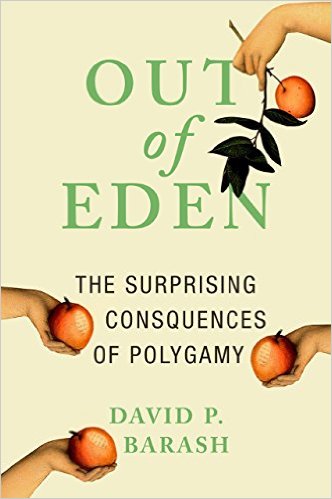 David Barash's Out of Eden examines the prevalence of polygamy in humans (it's more common than you think) and other species. First, he has to define the terms. Have you ever heard of the first term of the three below?
David Barash's Out of Eden examines the prevalence of polygamy in humans (it's more common than you think) and other species. First, he has to define the terms. Have you ever heard of the first term of the three below?
- Polygyny: When a man has more than one wife.
- Polyandry: When a woman has more than one husband.
- Polygamy: When a human has more than one spouse. Because polyandry is extremely rare, polygamy is usually synonymous with polygyny.
Right from the beginning, he recognizes that this is a touchy subject.
The biological reality is that we were "made for monogamy," despite the preferences of straight-laced (and often hypocritical) preachers, and not for free-spirited sexual adventurism either, despite the fervent desire of those seeking to justify a chosen "swinging" lifestyle.
Barash has company in the scientific community when he states that humans have polygamous tendencies. Primatologist Alan Dixson wrote a book about primate mating systems and concluded, "It is likely that Homo sapiens evolved from a primarily polygynous nonhuman primate precursor, and that the earliest members of the genus Homo were to some degree polygynous."
The esteemed Harvard biologist E.O. Wilson also agreed that humans were "moderately polygynous."
At the start of the book, Barash insists that he's not trying to promote any particular way of life. He's all about science, not morals. Still, at the end of the book, he can't help himself and injects a bit of his morality. He says that while we tend to polygamy biologically, that doesn't make it right. Barash (rightfully) criticizes those who value anything that is "natural." Sometimes natural things are bad. Some natural plants are poisonous; we have "natural" tendencies to kill each other.
Out of Eden points to various smoking guns that testify to our polygamous nature:
- Lopsided male vs. female violence ratio: Men commit 10 times more violent crimes than women. It's a classic sign of polygamy in the animal kingdom. Male-on-male violence is at least 20 times more common than female-on-female violence. Such patterns hold throughout recorded history.
- Female sexual maturity is earlier than men. "In all polygynous species, females become sexually and socially mature at a younger age than do males."
- Native American tribes: "Nearly all the Indian tribes of North and South America are polygamous.
- Nearly all societies punish female infidelity more. "The patriarchal 'double standard' is pretty much a cross-cultural universal. Once again, this is because female infidelity raises the possibility of a man rearing another's children, whereas its male counterpart--for all the problems it may cause to the relationship--doesn't necessitate a comparable cost of cuckoldry."
Barash bashes the politically correct crowd that argues that girls and boys would be identical if it weren't for social conditioning and pressure. "It is downright dreary to have the same basic, male chauvinist distinctions between men and women, boys and girls, confirmed in study after study, starting in very young childhood, but there's no way around it."
Out of Eden observes: "Another cross-cultural universal: although both girls and boys typically undergo initiation rituals, these rites of passage are consistently more severe for the sperm-makers."
Speaking of violence, men are far more likely to carry the SRY gene. So what?
[The SRY gene] dooms its carriers to shorter lifespans, greater probability of death due to "accidents," as well as increased risk of being not only violent but also the victim of violence. The impact of this gene is such that substantially more than one-half of people who have run afoul of the law and are currently incarcerated carry it.
Some think polygynous male lions are terrible when they take over a pride since they kill young males. However, even God in the Holy Bible instructs his followers to do the same: "Now therefore kill every male among the little ones, and kill every woman who has known man lying with him. But all the young girls who have not known man lying with him, keep alive for yourselves." (Numbers 31:17-18)
God wasn't just for polygamy, He's also a polygamous Himself! In Ezekiel 23, God is said to have two women (Samaria and Jerusalem). They are cities, but it's a symbol of bigamy.
"In addition," Out of Eden notes, "There are scores of patriarchs in the Old Testament who were polygamous." Yes, even Abraham, Esau, and Gideon had more than one wife. King Solomon had 700 wives and 300 concubines (1 Kings 11:1-3).
Koranic law limits Muslims to four wives, while the West African King of Ashanti had to be content with no more than 3,333 wives. Tough life.
Pan-African polygamous traits
One Pan-African trait I've noticed isn't just that polygamy exists in every African country and that men must always pay a bride price.
Not only that, but they typically have the right to return their purchase if it proves unacceptable; for example, if the bride isn't a virgin, doesn't conceive children, etc. A careful review of more than 200 different societies concluded that almost universally, husbands and their families show particular concern about the fertility of wives, with '"barrenness" being a predictable grievance.
Out of Eden argues that men fight to obtain the most resources in polygamous societies. The more they have, the more wives they have because wives are attracted to men with resources. The more wives they have, the more children they have. But what about African societies that are resource-poor?
Kalahari Bushmen, who inhabit a stringently resource-limited environment and are primarily monogamous as a result (in such circumstances it is difficult for a man to accumulate substantially more of anything than his fellows), 5% of the men nonethless manage to have two wives. In this and other cases, male success is less influenced by aggressiveness or violence than by ability to obtain resources which, in turn, are appealing to women: e.g., being a proficient hunter. In such cases, the proximate lure may well be the prospect of regular, nourishing meals, while the ultimate payoff is likely to be reproductive.
The doggone Dogons
Anthropologist Beverly Strassman has done for the Dogon people something they haven’t done for themselves: document their male-female relations. Dogon society is all about the man. It’s patriarchal (men hold the social, economic, and political power). It’s patrilocal (the wives must move into the man’s house, which is a common Pan-African trait). It’s patrilineal (sons inherit everything; the daughters get nothing).
During menstruation, the Dogon must move to a special hut, where she’s closely monitored. Dogons circumcise their women to theoretically decrease their sexual pleasure and appetite and thereby increase the likelihood of fidelity.
What’s the reward for Dogon women who make all these sacrifices?
Crappy husbands.
David Barash notes in Out of Eden:
[Dogon men] aren’t very dutiful fathers, spending most of their time and energy in the mating effort. They seek to enhance and maintain their social status, and with it, opportunities for more wives and thus, more children to be ignored. And so, child mortality is terribly high, with nearly one-half dying before reaching five years of age. Moreover, a Dogon child living in a polygamous family is seven to eleven times more likely to die early than if she or he is born to a monogamously mated woman. This appears due to the crucial reality that with monogamy, a woman’s success is also her husband’s, and ditto for losses. Polygamous males, on the other hand, are evolutionarily rewarded for emphasizing quantity over quality: a ‘father’ with three wives, each of whom suffers about a 50% probability of losing her child, still ends up with 1.5 children on average, compared to a monogamously mated man, who even assuming zero mortality among his offspring, ends up with only 1.0.
Like most polygynous societies, co-wives have a hierarchy. “Nearly always, the senior wife is more powerful and thus better served by polygyny than the younger, subsequent wives. It is therefore possible that at least some harem-dwelling women aren’t necessarily worse off as the reigning male acquires additional mates.”
After having talked with hundreds of female Africans, they’d disagree. They would say they become worse off even if they are the first wife. That’s because polygyny is essentially a zero-sum game: the pie is fixed, so any additional wives simply make each slice smaller.
Yes, a new wife can help contribute to babysitting and other domestic chores, but what the husband brings home matters. And it’s unlikely that he will be able to bring much more if he acquires another wife. He’ll still have the same job. It’s unlikely he’ll get promoted just because he got a second or fourth wife. Even in the old days, it was unlikely that a man would catch more meat if he got another wife.
Out of Eden points out another impact of Malian polygamy: “It isn’t clear precisely why the children of Dogon co-wives suffer such high mortality, although it is widely claimed—among Dogon women themselves—that they are often poisoned by other co-wives.”
Polygamy in Sierra Leone
Among the Mende people of Sierra Leone, for example, monogamously married women produced more children than did polygynous co-wives, on average. However, within these polygynous mateships, the most senior wives not only had greater reproductive success than their junior compatriots, but more than monogamously mated women. Since there is a dominance hierarchy among females, it may only be the ‘junior wives’ who suffer, and who might do better if they were monogamously mated.
He continues:
Out of a sample of 246 married men among the Temne people of Sierra Leone, 133 were polygynist, who were more ‘fit’ (that is, more surviving children per man) than were monogamous men. Not only that, but their ‘fitness’ increased with corresponding increases in harem size. Temne women, however, were a different story. One-quarter of the children born to monogamously mated women failed to survive infancy, whereas among bigamously mated women, infant mortality was a whopping 41%.
Polygamy in Kenya
Another example: among the Kipsigis people of Kenya, the number of surviving children declined with the number of co-wives. Thus, a monogamously married Kipsigis woman had, on average, 7.05 surviving children; a bigamously married woman, 6.82, whereas women with two or three other co-wives had 5.58 and 5.81, respectively.
In short, when a man decides to take a second wife, this is nearly always bad news for the first one. She will have to share resources and almost certainly compete with the new—and likely younger—wife and her eventual children.
Other convincing data polygynously mated women in the Sub-Sahara suffer more than those who are monogamously mated: more mental illness, especially depression, and more physical abuse.
In addition, their children fare worse by most measures. The situation is typically most challenging for junior wives, who are more likely to have lower reproductive success because their infants suffer higher mortality rates.
Polygamy in Nigeria
Monogamous Nigerian Ibo wives “actually encourage their husbands to take an additional wife, the claim being that it is not only lonely to be an ‘only wife,’ but humiliating as well, since it suggests that one’s husband isn’t very successful or otherwise desirable.
"It is also possible that even though Dogon women are reproductively ill-served by polygyny (in terms of their success in rearing offspring), they recoup these losses via enhanced numbers of grandchildren if their sons are more likely to become successful polygynists; another case of greater reproductive success by ‘sexy sons.’”
Money and Marriage
“Women are particularly likely to end up with men who are especially high status and wealthy.”
Evolutionary anthropologist John Hartung used G. P. Murdock’s Ethnographic Atlas (covering 1,170 societies) and the Standard Cross-Cultural Sample (186 societies) to conclude that sons generally receive more inheritance than daughters.
Out of Eden explains the logic: “This preferential investment in sons, particularly on the part of upper-class families, isn’t only reflected in patterns of inheritance. In the great majority of human societies, wives are essentially purchased by the groom’s family, who, in doing so, are investing in their sons, and thereby, in their own eventual grandchildren.”
Those two ethnographic reference books also indicate that brideprice occurs in 52 to 66 percent of human societies. Dowry payment occurs in only a few East Asian societies and southern Europe.
Africans who marry up
[The Mukogodo people of Kenya] have long occupied pretty much the bottom rungs of their geographic region with regard to wealth and prestige. As a result, their reproductive opportunities are comparably limited, even though there is considerable interbreeding between the Mukogodo and neighboring groups. The problem for the Mukogodo is that their neighbors regularly out-compete Mukogodo men for wives, having more goats, sheep, and cattle to offer as bride price. As a result, the Mukogodo place substantially less value on their sons—whose breeding options are limited—than on their daughters, who have a real prospect of marrying up. Mukogodo girls receive better medical care than their brothers, and their survival (at least to age five) is higher.
The sex ratio of live births favors girls as well, suggesting—but not proving—that, in this case, infant boys may be the disproportionate victims of infanticide.
When analyzing the Standard Cross-Cultural Sample, a team of anthropologists concluded that sexual and emotional conflicts among co-wives happen more than 90 percent of the time; only one in four have a “close friendship” with a co-wife.
It takes a village
Anthropologist and primatologist Sarah Hrdy’s book, Mothers and Others, persuasively argues that bi-parental care is less natural than “allo-parenting,” where the extended family also helps to raise the child. “Multi-adult allo-parenting would seem to free dominant and powerful men even more to be polygynists,” concludes David Barash.
We’ve already noted that modern Western societies that are formally monogamous turn out to be effectively polygamous, especially when considering remarriages and the formation of second and third families. There is a substantial gender asymmetry: men remarry more than do women, and have more children in their subsequent marriages. This is due to the fact that by the time of a second or third marriage, the participants are older and fertility declines dramatically with age among women but not among men.
Is polygamy good for women?
Despite the drawbacks of being a co-wife, “polygyny is actually a better deal for women than for most men. Thus, under polygyny all women get mates (at least in theory) compared with only a very small proportion of men; monogamy is therefore an equalizing and democratizing system, for men, in that it immensely increases the likelihood that they, too, will be able to marry [and reproduce].”
3 Tidbits
A study of 58 different human societies found that divorce rates tend to peak at about four years after the birth of a child, suggesting that the primary function of monogamous unions is to get child-rearing off to a good start, after which the parents are inclined to start over.
The frequency of marriages in which the husband is not the genetic father of the mother’s children ranges from 0.03 to 11.8 percent.
Women get punished much more for infidelity than men. “Indeed, such attitudes extend back to the Egyptians, Hebrews, Babylonians, Romans, Spartans, etc., who defined adultery strictly by the marital status of the woman. If no man is ‘wronged,’ then essentially, no wrong is supposed to have been done."
Conclusion
As you can see, I took copious notes. I plan to quote from Out of Eden often for my future book, The Unseen Africa. There's much more to Out of Eden that I have discussed. I especially like his examples of primates and other animals. If these excerpts make you want to know more, buy the book.
VERDICT: 9 out of 10 stars.




